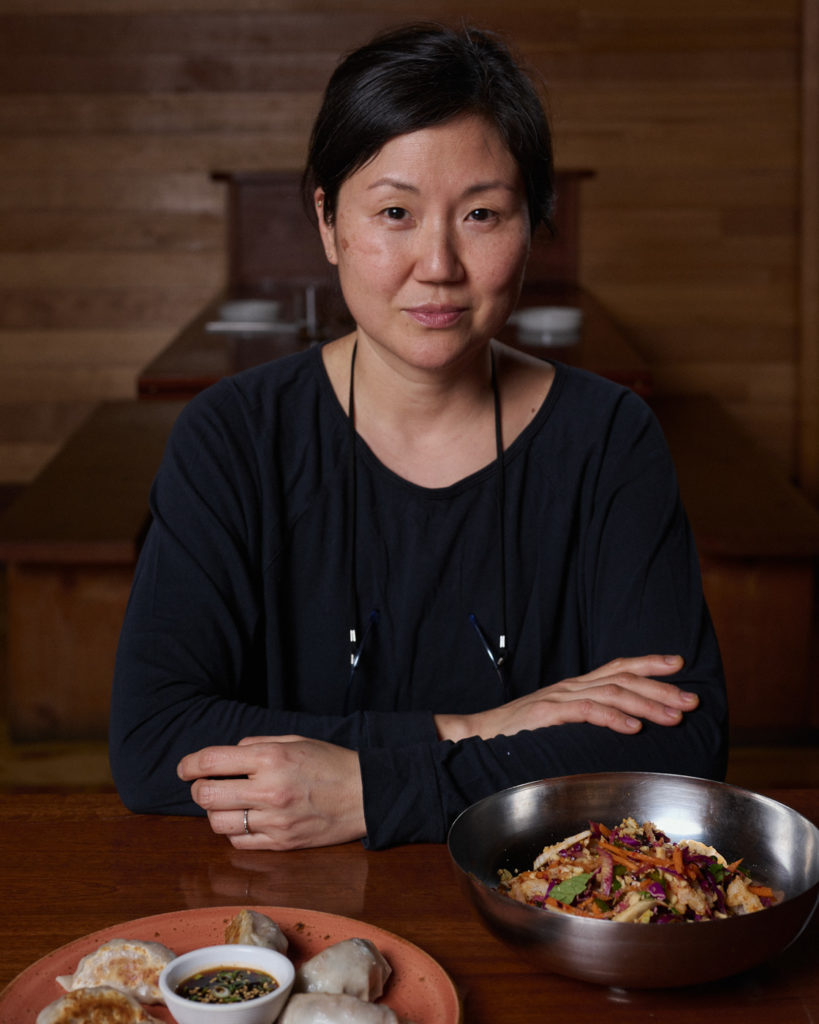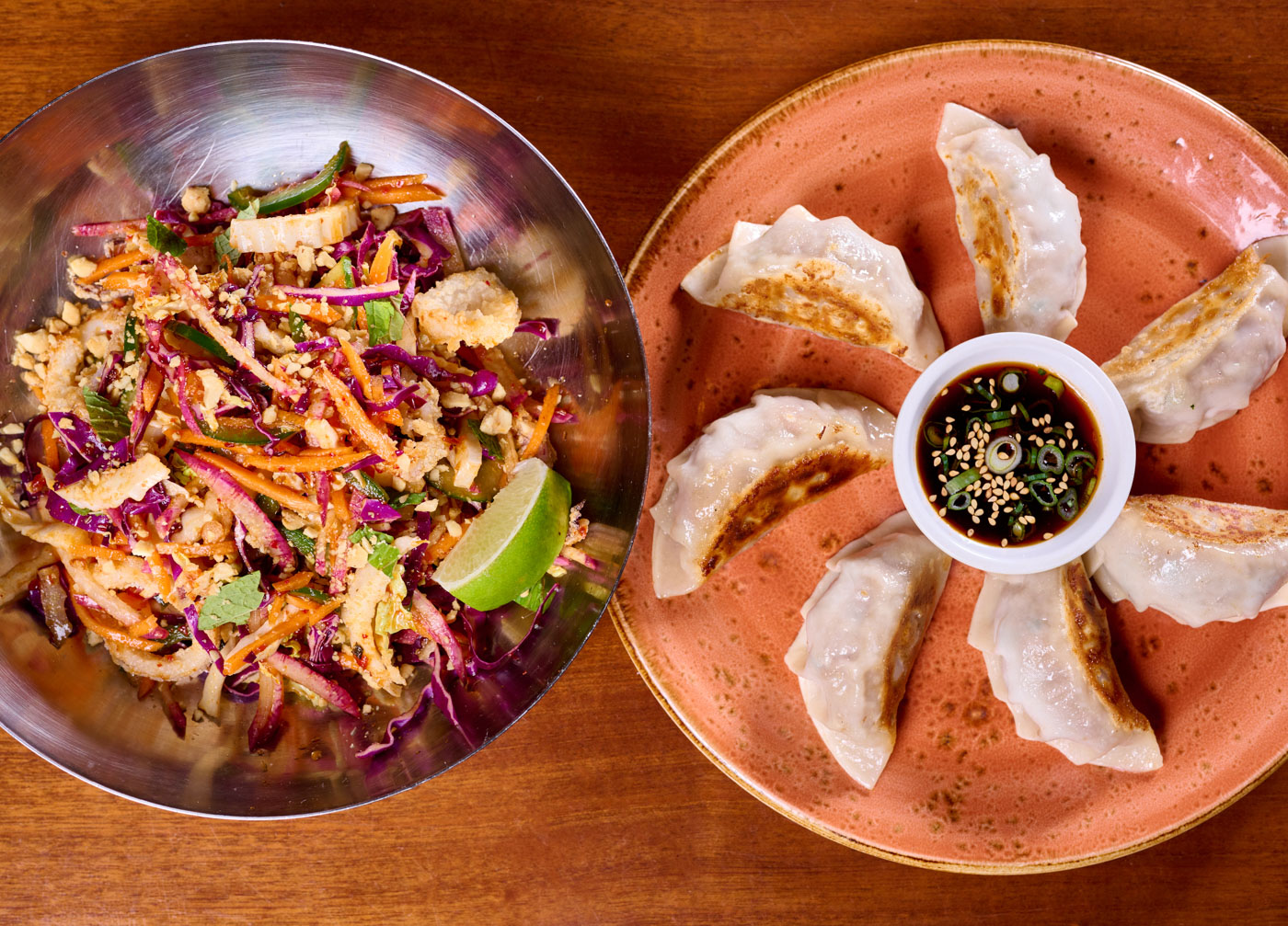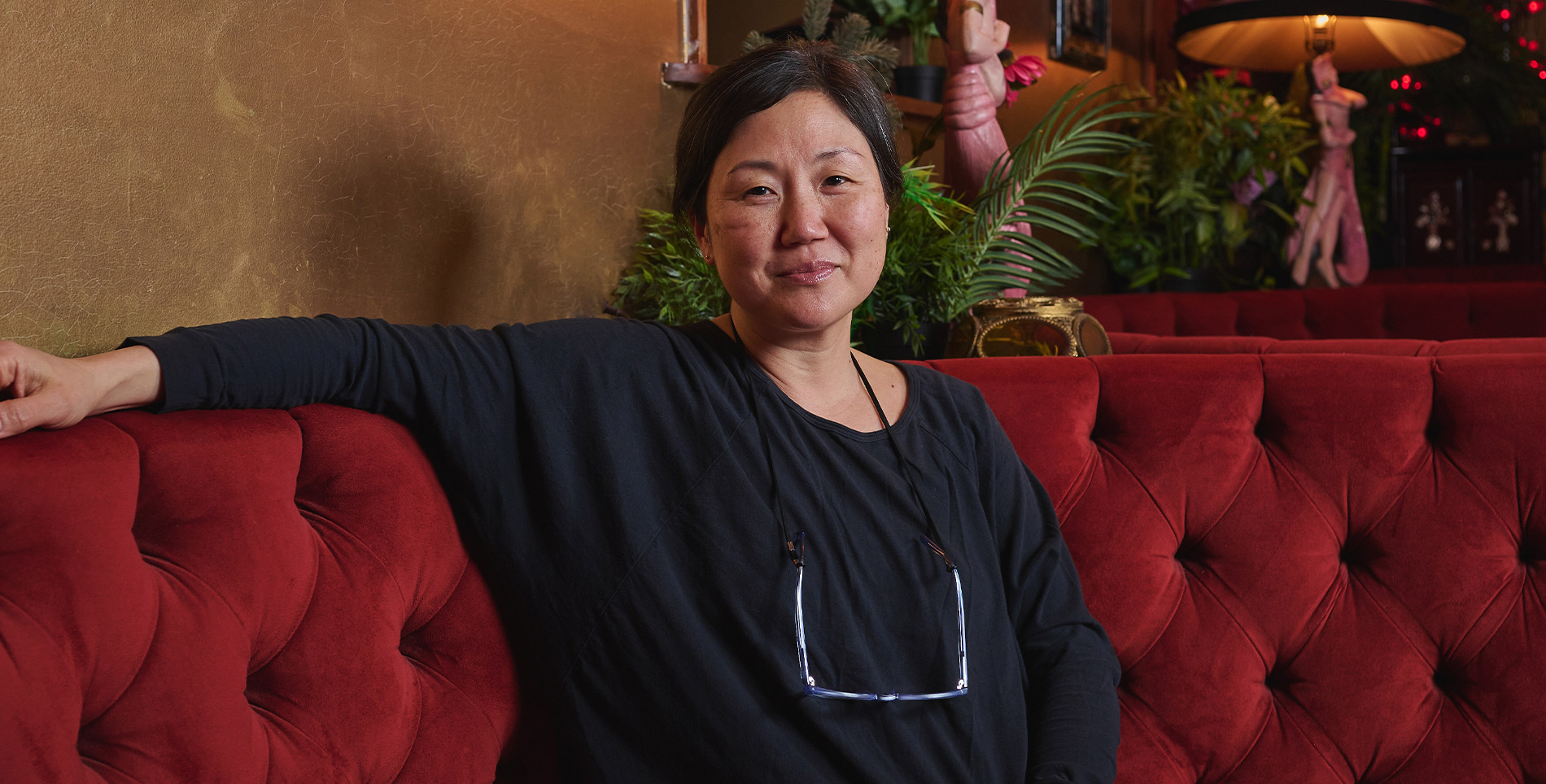Editor’s Note: this story is published in partnership with KCET / PBS SoCal and in association to The Migrant Kitchen, our Emmy-winning documentary series now on its fourth season.
Sohui Kim wants to rewind time. The wry, fast-talking, quick-thinking Brooklyn-based chef and owner of three restaurants—The Good Fork, Insa and Gage & Tollner—has deep memories of the sights, sounds and scents of a Buddhist temple she visited as a child growing up in South Korea. And more specifically, the grandmother who took her there for seven-day stretches during summer vacations.
Kim remembers feeling surly while plodding along on long foraging hikes to gather wild mountain edibles with the monks and worshippers like her halmoni. The rough feel of weeds in her hands on the bamboo tatami mats back at the temple gave her no joy—nor did the sight of the meju drying on the roof eaves, or the taste of the funky doenjang and gochujang fermenting from the season before. But she now fondly recalls the rhythmic chopping as the monks processed those foraged weeds and remembers picking the pigeon peas out of the japgok-bap, a hearty multigrain rice of millet, black beans and red beans.
“It’s the strongest regret in my memory,” Kim says. “I often think to myself, ‘Holy shit, if I could be my grown-up self and transport myself back there and replace that seven-year-old surly, bored child, what would I ask my grandmother and the monks about the way that Koreans survive by being fastidious—foraging, pickling and making things with patience, for years and years, until the doenjang and soy sauce are just right?’ To me, that’s Korean food and the way I aspire to be cooking.”
Kim says she’s proud to store that history in the deep emotional recesses of her brain, along with her identity as an immigrant. “I’m not second-generation or 1.5—I consider myself an immigrant, in that I was 10 when I came to this country. A lot of my ideas, tastes and perceptions of who I am as a Korean are rooted in those first 10 years.”
Although it’s what she’s now known for, Kim didn’t intend to cook Korean food professionally—in fact, she didn’t intend to enter the restaurant industry at all. Influenced by what she calls the “Korean American Ivy League dream” of her father—who passed away when she was 15—she studied at Bowdoin and Barnard.
“I was coming into my own in my early 20s, and I had to decide if I was going to chase a dead man’s dream of who he wanted me to be or forge ahead and follow my own dream,” Kim says.
Enrolling in culinary school, she learned French techniques and found the key to unlock her obsession with food—beyond consumption and into culinary fascination. She worked for talented Michelin-star-winning chefs like Anita Lo, who fused global ingredients with French techniques. But after shifts, the young chef found herself wandering off to 32nd Street in Koreatown, where all she wanted to do was bury her face in a deeply comforting, richly aromatic bowl of kimchi-jjigae.

The Good Fork
Still, Kim thought of Korean cuisine as food with which to nurture herself in her off hours, not the high-end dishes she was destined to cook on the line. It was her husband and business partner, Ben Schneider, who encouraged her to meld her sense for technique- and flavor-driven cuisine, her Korean and French expertise, and her passion for gathering people around food. Together, in 2006, they opened The Good Fork in the then-remote neighborhood of Red Hook, helping usher in the New Brooklyn cuisine movement by employing refined hospitality (think casually hip yet totally professional servers you would see biking to work), a cozy, upscale environment, and a borderless menu featuring everything from dumplings to handmade Italian pasta in wild boar ragu—the latter a recipe Kim learned from Italian chefs.
“We had a lot of pushback from family and friends about why we were doing American, Italian, French and Korean food on the same menu with fish and other dishes,” Kim says. “We said, ‘Why not? They go perfectly together.’ I wanted to look at each ingredient from whatever part of the world and then pay respect to it, in a way that’s culturally appropriate.”
In the mid-aughts, “fusion” was a buzz word in New York, which Kim says she hated. “Don’t confuse what I do with fusion,” she says. Her skirt steak and eggs, a dish visualized as wholeheartedly American, is elevated by a slightly spicy kalbi marinade that clearly telegraphs its smoky, sweet gochujang flavor, but it isn’t fusion so much as a reflection of what America truly is and always has been. The dish illustrates Kim’s ethos of taking something affordable and abundant, then elevating it with intense flavors, while remaining humble. The dish is, Kim says, what she always makes as a breakfast for friends. But coming from her ever-versatile hands, her steak is also easily convertible to dinner with a bed of kimchi fried rice and a perfectly fried egg on top.
With the freedom to explore flavors and experiment with recipes at her own restaurant, Kim thrived. She played with the notion of what a dumpling is, swapping out fillings and making the wrapper thinner. “I had a ton of fun because it was my own personal project and I just made what I wanted. People were really embracing it,” she says.
In 2015, after operating The Good Fork for almost a decade, Kim had another revelation. With two young children under seven years old, she was cooking prolifically at home, making Korean classics like jeon and bibimbap twice a day. After regularly hauling her children to Queens’ Koreatown to learn their ancestral dishes, she realized Brooklyn needed its own culturally Korean restaurant—and her career needed its own reckoning with her personal history.
“It didn’t surprise me that I was craving Korean food constantly and wanted to share it with my little babies at the time,” Kim says. “That’s how Insa was born.”
Insa
While motherhood’s desire to pass on cultural wealth was the brilliant inspiration for Insa—her Korean restaurant in Gowanus that opened in 2015—Kim was determined to experiment and pushed her menu’s boundaries with fun dishes like a seafood corn dog topped with mayo and gochujang ketchup. And despite her protests to her husband that she didn’t love karaoke—nor did all Koreans, contrary to stereotypes—she realized the value of installing machines at the restaurant to continue the party after dinner. Diners booked rooms to belt out pop music and quaff housemade soju in, uncorking the pressures of life in New York. With its long benches, convivial atmosphere, and all-night-long vibe, Insa invited its reputation as the epitome of modern Brooklyn cool.
Kim was stunned at Insa’s instantaneous popularity—America’s acceptance of Korean flavors has happened so rapidly. She says it wasn’t so long ago that she was in college and brought kimchi to her dorm room, her roommates were repulsed by the scent. “[They] were like, ‘What is that smell funking up the kitchen?’” she says. “I guess you can’t keep that kimchi a secret forever—how great tasting and amazing it is.”
While The Good Fork was a chance to prove her mettle, Insa was a true reckoning of her soul, identity and history. Opening an unapologetically Korean restaurant helped Kim examine her identity as she turned 45. “I took inventory and stock of my own personal life and what it means to be Korean, with a lot of reflection on my personal history as a child and an immigrant—the way our family struggled, how food played such a strong role, and what kind of glue that food provided,” Kim says.
During the period of creating Insa’s menu, Kim was excited by the professional challenge of cooking—and innovating upon—her childhood foods. She went into the kitchen and started cooking from memory. When her memory failed, she called her mother. “My mother didn’t cook with recipes, but I kept telling her I needed a recipe. She’d say, ‘Just throw in a little of this,’” Kim laughs.
On the evolution of Korean food, Kim says that at Insa she wanted to use cooking methods to bring more history to the cuisine, while innovating and defying ideas of authenticity. As Korean food gained mainstream popularity in the United States in the ‘80s and ‘90s, she found barbecue or tteokbokki at Korean American restaurants overly sweet. As a political science major in college who wrote a thesis on the potential reunification of North Korea and South Korea, she knew that scarcity due to wars meant most Korean cuisine did not contain that level of sugar or sweeteners.
Instead of leaning on overly easy and cloying solutions like sugar or even 7 UP (a popularized Korean cooking ingredient), she used rice syrup or Asian pears. In recreating yukgaejang, one of her father’s favorite recipes, she brunoised and seasoned raw beef with white soy and sesame oil, brunoised Asian pear, and added deep-fried capers for tartness and salt. “It was sacrilege for some people, but it tasted great and I fully stand by that dish whenever people criticize me for using fried capers in a yukgaejang,” Kim says. “When you talk about authenticity, what is really authentic?”
When Kim and Schneider’s good friend St. John Frizell, also a Red Hook resident and the owner of nearby acclaimed cocktail bar Fort Defiance, asked the couple to consult on a cocktail bar concept, they were happy to help. Kim would assist with a food menu and Schneider would help Frizell design and build his new concept, entitled Sunken Harbor Club.
Schneider went with him to look at a few small potential spaces in Frizell’s target area of Downtown Brooklyn, but they didn’t like any of the properties they saw. Out of desperation, their real estate agent showed them the landmarked Gage & Tollner space, which had been closed since February 14, 2004. “Their jaws dropped,” Kim says. “And the rest is history.”

Gage & Tollner
That is, quite literally, history. As Kim and Schneider began to examine Gage & Tollner’s illustrious history, from its landmarked status as a beautiful example of Victorian design, to its culinary fame as the spot where Chef Edna Lewis led the kitchen in the late ‘80s, they found themselves intrigued. Ideas started bubbling up between the pair, who reveled in historical spaces. The trio signed a lease and began a deep dive into the archival Gage & Tollner menus, dating back 125 years. “The challenge of bringing back an old oyster and chop house from the dead and into the 21st century was really enticing to me,” Kim says.
Schneider decided to oversee infrastructure, design and renovation, as well as building out Frizell’s Sunken Harbor Club cocktail bar upstairs. Kim dedicated herself to the opening team of creatives, as well as the menu and vision. But, as fate would have it, their opening date was March 15, 2020.
The day before Gage & Tollner was set to open, it was forced to close due to Covid—with over $50,000 of food in the walk-in. For over a year, they clung to their opening crew, managing to keep all their team members in tow for their reopening on April 15, 2021.
The restaurant has found a fine balance between old and new Brooklyn. Paying respect to the ingredients and tradition of its historical food, the restaurant serves classic recipes like clams on the half-shell, parker rolls, crab cakes, and sirloin and ribeye steaks. It also adds some of Kim’s signature Korean style to the menu, including her clams kimsino in bacon-kimchi butter, and the kale and kimchi slaw that accompanies fried chicken.
When asked about how she wrangled yet another new menu, Kim is modest. “I cook the food I want to eat,” she says. “I just want them to say, ‘She has really good sohn mat.’”
The Korean word means “hand-taste”—and can be compared to a gardening green thumb. The term connotes the ability to massage ingredients with a magic touch, producing soulful food from one’s hands. According to conventional wisdom, some people have sohn mat and others don’t. The monks at Kim’s grandmother’s temple had it, teaching worshippers to patiently cultivate fermenting doenjang. Kim’s mother had it. And Kim hopes she has it too.
“My life couldn’t have been any other way than it is right now—this notion of home, this notion of feeding ourselves, my pride in my Korean food,” the chef says. Kim says she’s proud to be amongst celebrated colleagues as Korean cuisine has soared in America. “With the evolution of Korean food in terms of all these other amazing chefs who are Korean and Korean American, there is so much of what we all bring to the table.”
As she builds her small empire, it’s hard not to wonder if Kim will expand beyond Brooklyn. But for now, she feels hyper-locally rooted in Brooklyn, which she calls “the smallest big city ever, of 10 million people.” Although the Bronx is her hometown, Brooklyn is her home.
“I always said The Good Fork can’t exist anywhere outside of Red Hook, Insa can’t exist anywhere except in Gowanus, and Gage & Tollner has been in Downtown Brooklyn for over 120 years,” she affirms exuberantly. “Our community, our family, is not just myself and my husband and our two kids. It’s our extended restaurant families—the cooks, porters and servers who work at all three of our places as our family keeps getting bigger and bigger. I love it.”







Our comments section is for members only.
Join today to gain exclusive access.